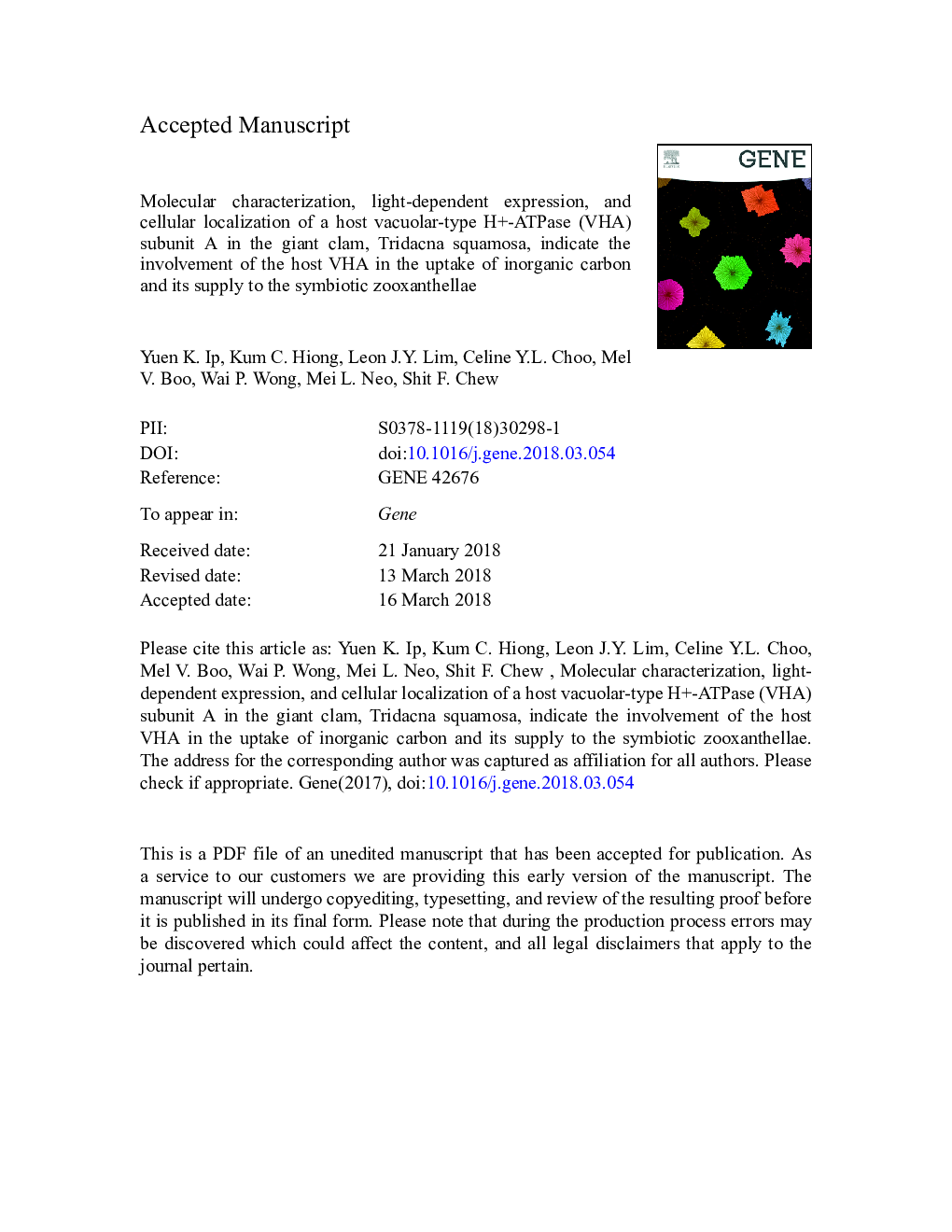| کد مقاله | کد نشریه | سال انتشار | مقاله انگلیسی | نسخه تمام متن |
|---|---|---|---|---|
| 8645208 | 1569777 | 2018 | 48 صفحه PDF | دانلود رایگان |
عنوان انگلیسی مقاله ISI
Molecular characterization, light-dependent expression, and cellular localization of a host vacuolar-type H+-ATPase (VHA) subunit A in the giant clam, Tridacna squamosa, indicate the involvement of the host VHA in the uptake of inorganic carbon and its su
دانلود مقاله + سفارش ترجمه
دانلود مقاله ISI انگلیسی
رایگان برای ایرانیان
کلمات کلیدی
IgGNa+/H+ exchangersVHACarbon-concentrating mechanismNHEsSymbiodiniumDAPIN-ethylmaleimideDICAMP4′,6-diamidino-2-phenylindole - 4 '، 6-دیامیدینو-2-فنیلینولCCm - CCMcDNA - cDNADNA complementary to RNA - DNA مکمل RNAAdenosine Triphosphate - آدنوزین تری فسفاتATP - آدنوزین تری فسفات یا ATPadenosine monophosphate - آدنوزین مونوفسفرهimmunoglobulin G - ایمونوگلوبولین GBicarbonate - بی کربنات، هیدروژن کربناتAcid-base balance - تعادل اسید-پایهrapid amplification of cDNA ends - تقویت سریع cDNA به پایان می رسدCarbon dioxide - دیاکسید کربنRace - مسابقهNEM - نهinorganic carbon - کربن معدنیCalcification - کلسیفیکاسیونdifferential interference contrast - کنتراست تداخل دیفرانسیلMantle - گوشته
موضوعات مرتبط
علوم زیستی و بیوفناوری
بیوشیمی، ژنتیک و زیست شناسی مولکولی
ژنتیک
پیش نمایش صفحه اول مقاله

چکیده انگلیسی
The giant clam, Tridacna squamosa, represents a clam-zooxanthellae association. In light, the host clam and the symbiotic zooxanthellae conduct light-enhanced calcification and photosynthesis, respectively. We had cloned the cDNA coding sequence of a Vacuolar-type Proton ATPase (VHA) subunit A, ATP6V1A, from T. squamosa, whereby the VHA is an electrogenic transporter that actively 'pumps' H+ out of the cell. The ATP6V1A of T. squamosa comprised 1866â¯bp, encoding a protein of 622 amino acids and 69.9â¯kDa, and had a host-origin. Its gene expression was strong in the ctenidium and the colorful outer mantle, but weak in the whitish inner mantle, corroborating a previous proposition that VHA might have a trivial role in light-enhanced calcification. Light exposure led to significant increases in the gene and protein expression levels of ATP6V1A/ATP6V1A in the ctenidium and the outer mantle. In the ctenidium, the ATP6V1A was localized in the apical epithelia of the filaments and tertiary water channels, indicating that the VHA could participate in the increased excretion of H+ produced during light-enhanced calcification. Additionally, the excreted H+ would augment HCO3- dehydration in the external medium and facilitate the uptake of CO2 by the ctenidium during insolation. In the outer mantle, the ATP6V1A was detected in intracellular vesicles in a type of cells, presumably iridocytes, surrounding the zooxanthellal tubules, and in the apical epithelium of zooxanthellal tubules. Hence, the host VHA could participate in the transfer of inorganic carbon from the hemolymph to the luminal fluid of the tubules by increasing the supply of H+ for the dehydration of HCO3- to CO2 during insolation to benefit the photosynthesizing zooxanthellae.
ناشر
Database: Elsevier - ScienceDirect (ساینس دایرکت)
Journal: Gene - Volume 659, 15 June 2018, Pages 137-148
Journal: Gene - Volume 659, 15 June 2018, Pages 137-148
نویسندگان
Yuen K. Ip, Kum C. Hiong, Leon J.Y. Lim, Celine Y.L. Choo, Mel V. Boo, Wai P. Wong, Mei L. Neo, Shit F. Chew,